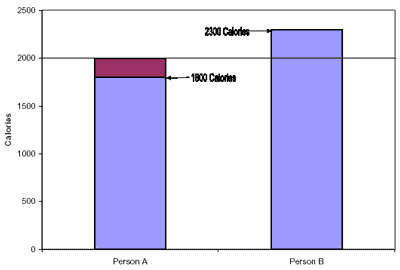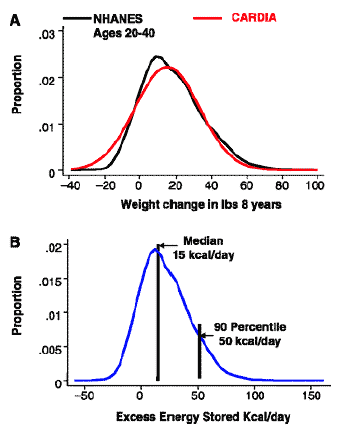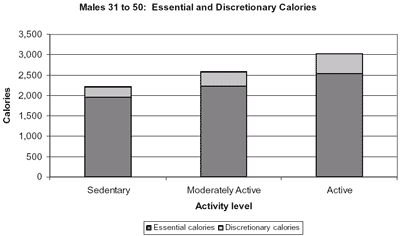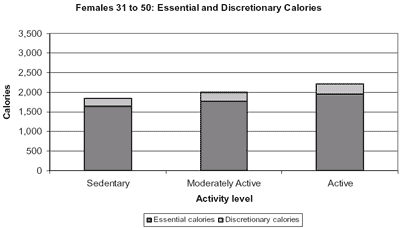PART D: SCIENCE BASE
Section 3: Discretionary Calories
Discretionary calories can be viewed from two different perspectives—in the context of (1) the sedentary lifestyle and typical food consumption of Americans or (2) diet planning.1 Both perspectives are covered in this section.
The daily amount of food a person needs to consume is driven
by two factors: (1) the need to meet recommended nutrient
intakes, and (2) the need to consume enough calories to match
energy expenditure and therefore maintain a stable weight.
By carefully choosing foods with higher-nutrient densities
and/or lower-energy densities, people can meet recommended
nutrient intakes while still consuming fewer calories than
their daily energy needs. In this situation, an individual
has a certain amount of calories left in his or her daily
caloric allowance—calories that can be used flexibly, since
nutrient needs already have been fulfilled. The Committee
named these remaining calories discretionary calories, and defined them as the difference between total energy requirements and the energy consumed to meet recommended nutrient intakes.
Back to Top
DISCRETIONARY CALORIES IN THE CONTEXT OF THE SEDENTARY LIFESTYLE AND TYPICAL FOOD CONSUMPTION OF AMERICANS
Because of sedentary lifestyles and food choices that frequently are relatively high in added sugars and solid fats, most Americans have used up discretionary calories even before meeting recommendations for nutrient intakes. The maximum amount of discretionary calories is based on the difference between their total daily calorie requirement and the number of calories used to meet nutrient recommendations.
Discretionary calories can be available only when the amount of calories used to meet recommended nutrient intakes is less than the total daily calorie expenditure. The magnitude of this difference, and whether it is positive or negative, depends on two factors: (1) the nutrient content of the foods consumed, and (2) the total energy requirement, which, in turn, is greatly dependent on the level of physical activity.
Figure D3-1 presents an illustrative example of the concept of discretionary calories. Individuals A and B have the same estimated energy requirement (EER) of 2,000 kcal/day. However, Person A consumes foods that are rich in essential nutrients and low in added sugars and solid fats, and therefore meets his or her recommended nutrient intake for essential nutrients by consuming only 1,800 kcals in a day. This person has 200 kcals available as discretionary calories that day. Person B, on the other hand, by consuming nutrient-poor, energy-dense foods, consumes 2,200 kcals in a day, exceeding his total caloric needs by 200 kcals. Thus, this person not only has no discretionary calories, he or she has an excess caloric intake. If this caloric excess continues, Person B will gain weight gradually. Furthermore, in spite of consuming more calories than Person A, Person B may not be consuming his or her recommended amounts of nutrients because he or she consumes predominantly nutrient-poor, energy-dense foods.
This latter situation of overconsuming calories appears to be the most common in the U.S. population. Food intake surveys (e.g., the National Health and Nutrition Examination Survey) show that most adults have used up all or most of their discretionary calories. At present, Americans are consuming calories in excess of calorie needs (as manifested by the high prevalence of overweight and obesity) (Flegal et. al., 2002, Hedley et al., 2004, Ogden et al., 2002). Many Americans, however, have inadequate intakes of nutrients (See Part D, Section 1,
"Aiming To Meet Recommended Intakes of Nutrients"). This pattern of nutrient inadequacy in the face of calorie excess results because Americans often consume nutrient-poor foods (e.g., sugar-sweetened beverages), because they choose to consume more energy-dense foods (e.g., whole-fat rather than nonfat milk), and because they are sedentary. Hence, persons who follow typical American eating and activity patterns have used up all their discretionary calories and more likely are consuming diets well in excess of their energy requirements for their age, gender, and physical activity level.
It seems clear that the desirable goal for a person is to have some discretionary calories available. This would allow more flexibility in food choices, and will give extra room to consume additional healthy foods, such as fruits and vegetables. How can a person increase his or her discretionary calories? There are two ways:
By increasing physical activity—Burning more calories increases total caloric needs, and increases the maximum amount of calories a person can consume daily. The active level is the desirable level of physical activity (see below and also Part D, Section 2
"Energy"). By consuming nutrient-dense foods that are relatively lower in energy density (i.e., a healthy diet).
Estimating Discretionary Calories for Meal Planning
To estimate how many discretionary calories different groups might have available,
the Center for Nutrition and Public Policy (CNPP) provided the Committee with
estimates of essential calories obtained using data from the U.S. Department
of Agriculture (USDA) food intake pattern and estimates of energy requirements.
Discretionary calories = Total estimated daily energy requirement (kcal) minus essential calories.
The estimated daily energy requirement is calculated using the method described below, and the value for essential calories is calculated by estimating the total number of calories provided by the specified amounts of foods for that calorie level from Table D1-13 (see also
"Essential Calories" below).
Calculating the Estimated Energy Requirement
To estimate how many discretionary calories persons might have available if they followed the revised USDA food pattern, USDA's CNPP used the following equation: (for a calculation to estimate energy requirement for children, see Dietary Reference Intakes for Energy, Carbohydrate, Fiber, Fat, Fatty Acids, Cholesterol, Protein, and Amino Acids (IOM,2002)2:
Daily estimated energy requirement (kcal) = A + B x age in years + PA x ( D x weight in kg + E x height in meters)
where:
A = constant term = 662 for men, 354 for women
B = age coefficient = 9.53 for men, 6.91 for women
PA = physical activity coefficient =
| |
|
| 1.00 |
1.00 |
for PAL >1.0<1.4) |
| 1.11 |
1.12 |
for PAL >1.4<1.6) |
| 1.25 |
1.27 |
for PAL >1.6<1.9) |
D = weight coefficient = 15.91 for men, 9.36 for women
E = height coefficient = 539.6 for men, 726 for women
Sedentary means a lifestyle that includes only the light physical activity associated with typical day-to-day life.
Moderately Active means a lifestyle that includes physical activity equivalent to walking about 1.5 to 3 miles per day at 3 to 4 miles per hour, in addition to the light physical activity associated with typical day-to-day life. This represents activity at the lower limit of the physical activity recommendation for adults (i.e., a minimum of 30 minutes of at least moderate intensity physical activity) (see Part D, Section 2,
"Energy").
Active means a lifestyle that includes physical activity equivalent to walking more than 3 miles per day at 3 to 4 miles per hour, in addition to the light physical activity associated with typical day-to-day life. This corresponds to a minimum of 60 minutes of at least moderate intensity physical activity (see Part D, Section 2,
"Energy").
Back to Top
ESSENTIAL CALORIES
Essential calories represent the number of calories needed to meet
recommended nutrient intakes through the consumption of foods (from the basic
food groups) in their low-fat or no-added sugars forms (see note on discretionary
calories in Table D1-13 (The Revised USDA Food Intake Pattern for Meeting Recommended
Nutrient Needs) and Table D1-14 (Discretionary Calories in the Revised USDA Food
Intake Pattern). For the purposes of estimating essential calories, all the foods
are present in their nutrient-dense, low-energy lean or low-fat forms without
any added sugars. That is,
Only nonfat milk is included from the milk group—cheese and even low-fat milk contain fat that is counted as part of discretionary calories The meats are very lean The grain products do not include sweetened cereals, muffins, or others that contain added sugars and/or added fat The vegetables do not include items made with fat, such as French fries. The fruits do not include fruits canned in syrup or other fruits and juices that contain added sugars The oils and trans-free soft margarines included in the calculation of essential calories are amounts that meet essential fatty acid needs and also contribute toward vitamin E needs
Amounts of Discretionary Calories That Can Be Available
By referring to Table D1-13 in Section 1, one can find the estimated number
of discretionary calories that can be available when using the Revised USDA Food
Intake Pattern for diet planning. This number ranges from 154 calories for young
children whose energy requirement is 1,000 calories to 334 for persons whose
energy requirement is 3,000 calories. Table D1-14 identifies many of the sources
of discretionary calories.
Typical Total Energy Needs of Different Population Groups
Table D3-1 gives estimates of the total energy requirement of people in different
age and/or sex groups for three levels of physical activity. These estimates
can provide a starting point for people who want an idea of approximately how
many calories are needed to maintain their weight.
In the United States, a large proportion of the adult population is consuming more calories than expended as evidenced by gradual weight gain. The average 8-year weight gain among subjects age 20 to 40 was 14 to16 pounds in the longitudinal CARDIA study and in the cross-sectional NHANES data set (Hill et al., 2003). Hill and colleagues (2003) estimated the distribution of weight gain within the population and the amount of excess energy storage that would be required to support this population-wide pattern of weight gain (see Figure D3-2). The authors estimated that 90 percent of the population consumed up to 50 kcal per day in excess of their caloric requirement during this 8-year period, and this resulted in the weight gain of about 2 pounds per year. The authors hypothesized that a caloric deficit of as few as 50 to 100 kcal per day could prevent weight gain or promote modest weight reduction in about 90 percent of the population.
Back to Top
PHYSICAL ACTIVITY AND DISCRETIONARY CALORIES
Increasing physical activity is the way to increase one's total energy requirement for weight maintenance. Thus, increasing physical activity is the major way a person can increase the amount of discretionary calories available. Another way is to choose nutrient-dense foods that are in their most lean, low-calorie form to meet one's nutrient needs.
Figures D3-3a and D3-3b graphically represent estimates of the number of discretionary calories that would be available for men and women at three different activity levels—sedentary, moderately active, and active,3 assuming that they consume nutrient-dense foods that are relatively low in energy density. That is, the levels of physical activity addressed in these figures ranges from only the light physical activity associated with typical day-to-day life (i.e., sedentary) to about 60 minutes of moderate physical activity daily in addition to the light physical activity of daily living (i.e., active). Some individuals may need up to 60 minutes of at least moderate intensity physical activity to prevent unhealthy weight gain. The amount of physical activity that weight-reduced adults need to avoid weight regain is estimated to be from 60 to 90 minutes daily at moderate intensity.
These figures show that the more physically active a person is, the more calories he or she requires to attain energy balance, and the more flexibility there is in consuming those calories after meeting recommended nutrient intakes. These estimates were made for individuals of median height and healthy body weight. Estimates would be higher for larger persons.
Note in Figures D3-3a and D3-3b that essential calories increase slightly with increased physical activity. This is because the recommended nutrient intake for fiber increases as an individual engages in more physical activity. It also allows for the food intake pattern to come closer to meeting recommended intakes of potassium and vitamin E.4 This means that the increase in discretionary calories earned through physical activity may be slightly smaller than expected. If foods rich in fiber, potassium, and vitamin E are consumed while meeting other nutrient needs, more of the calories earned through physical activity could be considered discretionary calories.
The essential calorie values shown in the Figures D3-3a and D3-3b are estimates obtained using a specific food modeling approach that incorporates commonly used foods that are not necessarily the richest sources of nutrients. This means that one could increase the number of discretionary calories available by making food selections (from the basic food groups) that are especially rich in the nutrients that tend to be in short supply—especially vitamin E, potassium, and fiber. By meeting recommended nutrient intakes with a smaller number of calories, more discretionary calories become available. However, since the calculations of essential calories assume a healthier diet than most Americans currently consume, selecting foods that are even richer in nutrient content than the foods used in the food modeling approach could be a challenge.
Back to Top
WAYS THAT DISCRETIONARY CALORIES ARE USED UP
Most people have no discretionary calories because of their sedentary lifestyle and selection of energy-dense foods. However, if discretionary calories are available, they can be used in a variety of ways. Often, discretionary calories come from intrinsic fats found in foods in one or more of the basic food groups. For example, drinking low-fat milk rather than skim milk uses some discretionary calories, as does eating a medium-fat hamburger patty instead of a lean cut of meat. The USDA food modeling method counts most solid fats and all added sugars as
"discretionary." Alcoholic beverages also count as discretionary calories. Discretionary calories add up quickly. For example, a 12 oz soft drink counts as about 150 discretionary calories because of the added sugars it provides, the fat in one cup of 2 percent milk counts as about 32 discretionary calories, and a 12 ounce can of beer counts as about 150 discretionary calories. This exceeds the total amount of discretionary calories that could be available for many persons.
Back to Top
KEY POINTS REGARDING DISCRETIONARY CALORIES
The best way to increase the number of discretionary calories is to increase physical activity (see Figures D3-3a and D3-3b). The greater the amount of physical activity, the more discretionary calories will be available. Another way to increase the number of discretionary calories is to make nutrient-dense selections from the basic food groups, especially of foods that are very good sources of vitamin E, potassium, calcium, and fiber. For good health, the goal is to be sure to obtain recommended nutrient intakes from the basic food groups and oils/trans-free soft margarines before consuming discretionary calories. Even if many discretionary calories are available, keeping saturated and trans fat intake very low is advisable to help reduce the risk of heart disease (see Part D, Section 4,
"Fats").
Intake of no more than one serving of alcohol per day for women and two servings per day for men is advisable—even if many discretionary calories are available (see Part D, Section 8,
"Ethanol"). For weight maintenance, the aim is to consume essential calories plus discretionary calories to equal total energy expenditure. For weight loss, the aim is to consume essential calories but to consume only part of the discretionary calories. In this way, calorie intake will be less than total energy expenditure, but recommended nutrient intakes will be achieved.
Back to Top
SUMMARY
Discretionary calories are calories remaining when an individual meets his or her recommended nutrient intake while consuming fewer calories than his or her daily energy requirement. Discretionary calories can be available only when individuals consume nutrient-dense, lower-energy density foods and maintain an adequate level of physical activity.
At present, Americans are consuming calories in excess of calorie needs (as manifest by the high prevalence of overweight and obesity) but are not meeting recommended nutrient intakes. This pattern of calorie intakes exceeding energy expenditure results because Americans often consume nutrient-poor and energy-dense foods and because they are increasingly sedentary. Therefore, Americans have few, if any discretionary calories.
To make discretionary calories available or to increase the amount of discretionary calories, individuals need to
When available, discretionary calories can be used to consume additional foods from the basic food groups and/or foods in the recommended food groups that are higher in solid fat and/or that contain added sugar.
Back to Top
REFERENCES
Flegal KM, Carroll MD, Ogden CL, Johnson CL. Prevalence and trends in obesity among U.S. adults, 1999-2000. JAMA 288:1723-1727, 2002.
Hedley AA, Ogden CL, Johnson CL, Carroll MD, Curtin LR, Flegal KM. Prevalence of overweight and obesity among U.S. children, adolescents, and adults, 1999-2002. JAMA 291(23):2847-2850, 2004.
Hill JO, Wyatt HR, Reed GW, Peters JC. Obesity and the environment: where do we go from here? Science 299(5608):853-855, 2003.
Institute of Medicine. Dietary Reference Intakes for Energy, Carbohydrates, Fiber, Fat, Fatty Acids, Cholesterol, Protein and Amino Acids. Washington, DC: National Academies Press, 2002.
Ogden CL, Flegal KM, Carroll MD, Johnson CL. Prevalence and trends in overweight among U.S. children and adolescents, 1999-2000. JAMA 288(14):1728-1732, 2002.
Back to Top
1This is the approach used
in Section D1 of this report. Tables
D-1-13 and D-1-14 use a precise definition
for discretionary calories for use in
diet planning.
2The Institute of Medicine
report includes four levels of physical
activity in their discussion of estimating
energy requirements. The Committee uses
three levels in this example, roughly
equivalent to the first three levels
in the Institute of Medicine report.
3As indicated in the equations
above, these are the three physical activity
levels used for the estimation of energy
needs. These levels differ from intensity
levels used by exercise physiologists
(i.e., low, moderate, and vigorous).
4Table D1-12, "Nutrients
in the Revised USDA Food Intake Pattern"
shows that the lowest calorie patterns
are especially low in vitamin E, and
many of the lower calorie patterns do
not provide 100 percent of the recommended
intake of potassium.
Back to Top
Table D3-1. Estimated Energy Requirements for Each Age/Gender Group at Three Levels of Physical Activity. (These levels are based on Estimated Energy Requirements (EER) from the Institute of Medicine Dietary Reference Intakes macronutrients report, 2002. See the notes for additional information.)
 Select icon to view table
Select icon to view table
Back to Top
Figure 3-1. Illustrative Example of the Discretionary Calories Concept
 d d
Person A, by consuming nutrient-dense, lower energy dense
foods fulfills his essential nutrient needs by consuming
only 1,800 calories - less than his total
daily energy allowance of 2,000 kcals/day. The remaining
200 calories are discretionary calories. Person B consumes
low-nutrient, high-fat and added sugars foods, and
exceeds his total caloric allowance. Person B has no discretionary
calories,
and is consuming an excess energy that, over time, will result in undesirable
weight gain.
Back to Top
Figure D3-2. (A) The Distributions for Weight Gain Over an 8-Year Period, Estimated from the NHANES and CARDIA Studies. (B) A Distribution of the Daily Energy Accumulation on the Adult Population Over the 8-Year Period, Assuming a Linear Accumulation of Body Energy (Hill et al., 2003).
 d d
Back to Top
Figure
D3-3a. Estimate of Discretionary Calories Available Based on the Level
of Physical Activity for Males 31 to 50 Years Old. (Estimated Energy Requirements from the IOM Dietary Reference Intakes macronutrients report, 2002, are calculated by median height (1.77 m) and weight (70 kg) for that height to give a BMI of 22.5 for a typical 30 year old adult male.)
 d d
Sedentary represents in dark gray the essential calories used
to consume a relatively nutrient-dense food pattern to meet nutrient needs for
a sedentary male and on top of the essential calories, in light gray, the remaining,
or discretionary, calories to achieve energy balance based on the USDA food modeling
system. Sedentary means a lifestyle that includes only the light physical activity
associated with typical day-to-day life.
Active represents in dark gray the essential calories used
to consume a relatively nutrient-dense food pattern to meet nutrient needs for
a low-active male and on top of the essential calories, in light gray, the remaining,
or discretionary, calories to achieve energy balance based on the USDA food modeling
system. Active means a lifestyle that includes physical activity equivalent to
walking about 1.5 to 3 miles per day at 3 to 4 miles per hour, in addition to
the light physical activity associated with typical day-to-day life and results
in a slight increase in essential calories for the active man.
Very Active represents in dark gray the essential calories
used to consumer a relatively nutrient dense food pattern to meet nutrient needs
for an active male and on top of the essential calories, in light gray, the remaining,
or discretionary, calories to achieve energy balance based on the USDA food modeling
system. Very active means a lifestyle that includes physical activity equivalent
to walking more than 3 miles per day at 3 to 4 miles per hour, in addition to
the light physical activity associated with typical day-to-day life, and results
in a slight increase in essential calories for the very active man.
Back to Top
Figure D3-3b. Estimate of Discretionary Calories Available Based on the Level of Physical Activity for Females 31 to 50 years old. (Estimated Energy Requirements from the IOM Dietary Reference Intakes macronutrients report, 2002, are calculated by median height (1.63 m) and weight (57 kg) for that height to give a BMI of 21.5 for a typical 30 year old adult female.)
 d d
Sedentary represents
in dark gray the essential calories used
to consume a relatively nutrient-dense
food pattern to meet nutrient needs for
a sedentary female and on top of the
essential, in light gray, the remaining,
or discretionary, calories to achieve
energy balance based on the USDA food
modeling system. Sedentary means a lifestyle
that includes only the light physical
activity associated with typical day-to-day
life.
Moderately Active represents
in dark gray the essential calories used
to consume a relatively nutrient-dense
food pattern to meet nutrient needs for
a moderately active female and on top
of the essential calories, in light gray,
the remaining, or discretionary, calories
to achieve energy balance based on the
USDA food modeling system. Moderately
active means a lifestyle that includes
physical activity equivalent to walking
about 1.5 to 3 miles per day at 3 to
4 miles per hour, in addition to the
light physical activity associated with
typical day-to-day life and results in
a slight increase in essential calories
for the moderately active woman.
Active represents in
dark gray the essential calories used
to consume a relatively nutrient-dense
food pattern to meet nutrient needs for
an active female and on top of the essential
calories, in light gray, the remaining,
or discretionary, calories to achieve
energy balance based on the USDA food
modeling system. Active means a lifestyle
that includes physical activity equivalent
to walking more than 3 miles per day
at 3 to 4 miles per hour, in addition
to the light physical activity associated
with typical day-to-day life, and results
in a slight increase in essential calories
for the active woman.
Back to Top |

